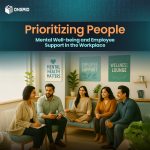Table of Contents
ToggleThe workplace has undergone a seismic shift in recent years. Hybrid models, remote-first cultures, and rapidly advancing technologies are reshaping how companies attract, integrate, and retain talent. At the heart of this transformation is the rise of the Digital Onboarding Platform—a solution designed to make the employee onboarding process seamless, scalable, and human-centric.
As we step into 2025, organizations of all sizes are realizing that onboarding isn’t just a checklist of paperwork—it’s the foundation for long-term employee engagement, productivity, and retention. And that’s exactly why digital onboarding platforms are no longer optional—they are essential.
What Is a Digital Onboarding Platform?
A digital onboarding platform is a cloud-based solution that automates and streamlines every stage of the new hire onboarding journey. From document collection and compliance verification to training modules, team introductions, benefits enrollment, and early feedback cycles—these platforms manage it all in a unified, accessible interface.
By replacing manual processes and disjointed communication with automation, analytics, and integration, digital onboarding platforms empower HR teams to deliver consistent, compliant, and engaging experiences that resonate with today’s digital-first workforce.
Key Benefits of Digital Onboarding Platforms in 2025

1. Faster and Paperless Processes
Gone are the days of endless paperwork, printing contracts, and manual follow-ups. Digital onboarding platforms allow new hires to submit documents, sign contracts electronically, and complete forms through secure links—anytime, anywhere. This speeds up the process while minimizing administrative load and human errors.
2. Enhanced Employee Experience
First impressions are critical. An intuitive, tech-savvy onboarding platform reflects a company’s professionalism and culture. From branded welcome kits and digital orientation videos to progress tracking dashboards and gamified learning, these platforms help new hires feel welcomed, supported, and confident from day one.
3. Support for Remote and Hybrid Workforces
As remote work becomes the norm, traditional in-person onboarding is no longer feasible. Digital onboarding platforms enable remote onboarding through video calls, virtual document verification, chatbots, and centralized communication tools—ensuring new hires feel connected regardless of location.
4. Compliance and Background Verification
Regulatory compliance is non-negotiable. Modern onboarding platforms come equipped with built-in verification tools to validate documents such as Aadhaar, PAN, or Social Security Numbers, depending on the region. Integration with background verification services ensures accurate identity, employment, and criminal history checks.
5. Integrated Workflows Across HR Ecosystems
Digital onboarding solutions integrate seamlessly with other HR tools—HRMS, payroll, learning management systems (LMS), and benefits platforms. This reduces data duplication, ensures smooth transitions, and keeps all stakeholders aligned in real time.
6. Customizable and Role-Specific Journeys
Every employee’s onboarding needs are unique. Whether it’s a sales executive or a senior engineer, platforms allow HR teams to customize workflows, assign department-specific training, schedule welcome calls, and set performance milestones tailored to each role.
7. Data-Driven Insights and Continuous Improvement
With inbuilt analytics and dashboards, HR managers can track progress, identify friction points, and collect feedback. This data enables continuous optimization of the onboarding experience—leading to higher completion rates and employee satisfaction.
Why Digital Onboarding Matters More Than Ever in 2025
1. Talent Competition Is Fierce
In today’s competitive hiring landscape, a poor onboarding experience can lead to candidate drop-offs—even after acceptance. Companies leveraging digital onboarding platforms show professionalism and efficiency, which helps in attracting and retaining top talent.
2. Gen Z and Millennial Expectations
The modern workforce expects digital fluency, transparency, and speed. A digital onboarding platform aligns with these expectations, offering mobile-first interfaces, self-service options, and instant access to important information.
3. Scaling with Agility
Whether hiring 10 or 10,000 employees, digital platforms enable organizations to scale onboarding efforts without adding overhead. Automated workflows eliminate repetitive tasks, allowing HR to focus on engagement and culture-building.
4. Higher Retention, Faster Productivity
According to industry research, employees who experience effective onboarding are 69% more likely to stay with the company for three years. Additionally, they reach peak productivity faster—leading to long-term ROI on both tech and talent investments.
Choosing the Right Digital Onboarding Platform
Here’s what to look for when selecting a digital onboarding platform in 2025:
Mobile-first user experience
Integration with HRMS, LMS, payroll, and BGV tools
Digital document management and e-signatures
Role-based workflows and templates
Automated email and SMS reminders
Onboarding progress dashboards and reporting
Data security, encryption, and regulatory compliance
Leading solutions like OnGrid, with robust background verification capabilities and a full-fledged portal, are making onboarding more seamless than ever. Designed to fit companies of all sizes — from startups to large enterprises — OnGrid helps automate the process without losing the human touch.
Its growing partnerships with HR platforms and smooth integrations are truly changing the game for modern hiring.
The Future of Onboarding Is Smart and Personalized
Looking ahead, digital onboarding platforms will become even more intelligent and adaptive. We’re talking AI-powered document review, automated benefits matching, and predictive analytics that suggest personalized learning paths for every employee.
Chatbots will guide employees through onboarding steps in real time. Machine learning will identify drop-off risks early. Integration with wellness apps, DEI programs, and employee recognition tools will make onboarding more holistic.
In short, the digital onboarding experience of the future won’t just be efficient—it’ll be empathetic, personalized, and strategic.
Final Thoughts
In 2025, onboarding is no longer a formality—it’s a strategic differentiator. A robust digital onboarding platform enables companies to turn new hires into loyal, productive team members by delivering an experience that is consistent, compliant, and people-first.
If your organization is still relying on spreadsheets and emails to welcome new talent, it’s time to evolve. Digital onboarding isn’t just a tech upgrade—it’s a mindset shift that prepares your workforce for long-term success.
FAQ’s
Q1. What is a digital onboarding platform?
It is a software solution that automates the process of welcoming and integrating new employees into an organization.
Q2.Why is a digital onboarding platform important in 2025?
With remote work, talent competition, and evolving employee expectations, digital onboarding platforms are crucial for engagement and compliance.
Q3. How does a digital onboarding platform enhance employee experience?
It personalizes the onboarding journey, reduces paperwork, and helps new hires feel connected and productive faster.
Q4. Do digital onboarding platforms help with training new employees?
Yes, many integrate with LMS tools or have inbuilt training modules.
Q5. Are these platforms accessible on mobile devices? Yes, mobile-first design is a standard feature of most platforms today.





Leave a Reply